Crappy Games
Not what Dreamspace President set out to create.
Contents
inspired by Matthew Brown's Hexcells a boring/interesting experiment complicated but awesome in its own way a nice Battleship implementation an incomplete but fun action game |
▲ contents
Stupid Little Minesweeper
download v[(2), 2016-06-14 05!00 UTC] (~20 KB Java 8 program)
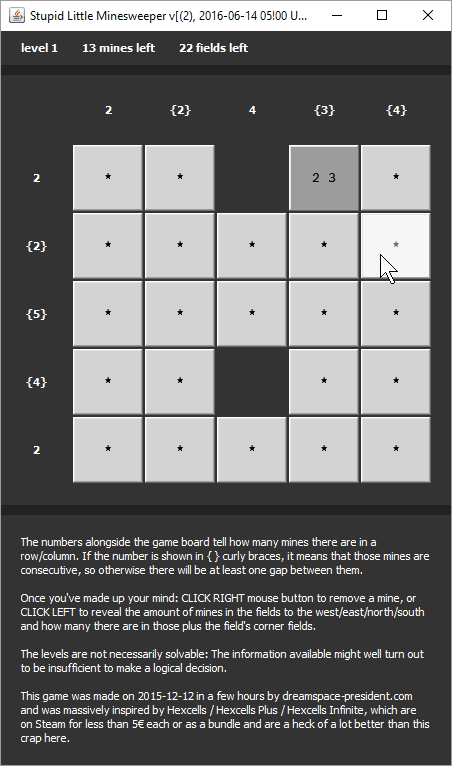
Playing the Hexcells series gave me a thirst for more (of its simpler puzzles), plus I wanted to see what it's like to develop a puzzle game, so on 2015-12-12 I whipped up this much less sophisticated variant that has a few key similarities.
Rules are explained in the screenshot. The game doesn't save anything (e.g. a highscore or whatever), it's just a window with buttons to have some brain-teasing fun with.
After each level, the grid size grows by one on both axes. The first screenshot shows the first level, the second shows the last level. They are different each time because everything's random - and there are no balancing checks. One of the reasons I call it "crappy".
System Requirements
PC, Java 8
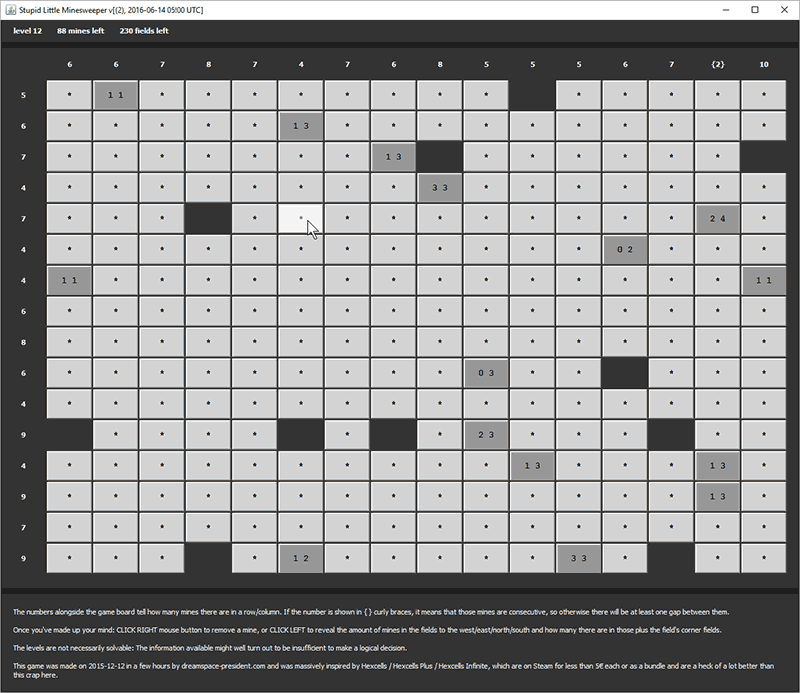 ▲ contents
▲ contents
▲ contents
Simple Skill Based Hack N Slash
download v[(2), 2016-06-14 05!00 UTC] (~15 KB Java 8 console program)
On Windows, the program should start via double-click because of my AutoRunFromConsole Java class, but otherwise you have to start it from the console yourself: java -jar nameOfProgram.jar
This simple little game I made on 2014-08-24 is a successful attempt at employing player skill. The first screenshot shows the main idea: A short cryptic text line is shown for a short moment, and you have to "feel" the amount of opening and closing parentheses and enter a number. E.g. if the String was "())", that's plus one, minus one, minus one, so you have to enter "-1" for a perfect result. (We start at 0.)
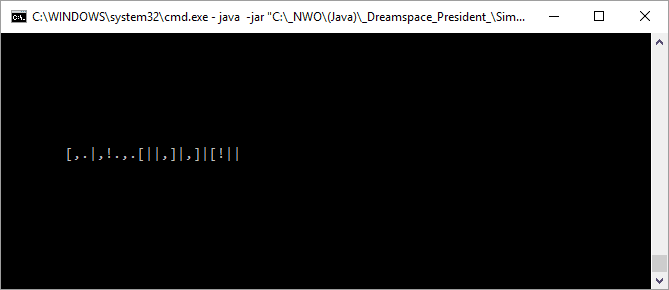
The closer your guess, the better the effect. You will have to fight increasingly capable foes, and you will have to enter a guess to attack and also to defend (where a perfect guess means no damage to you at all). The cryptic text changes depending on the type of foe, on the current level you are in the tower, and on the life points the foe has left. It's easy to mop the floor with rats, but prepare to get your ass handed to you by guards and by Ashwar himself.
There's no healing or items, it's just your own skill - and some randomness, which is your opponent's skill. Whether you successfully hit/defend is not random in the least. Try not to get hit too strongly, or you might get confused, which even spreads the cryptic text across a few lines for one round. Hey there, beginner programmer, what can be done with text alone has not yet been explored in full at all, so get going!

The difficulty selection is opposite of what you're used to: The idea is that if you're the fearless knight, you're good at what you're doing, therefore it's easier to you. The cryptic text will be visible for longer, and you'll have more life points.

Now go forth and rip Ashwar a new one! If you're skilled, a very rough guess is that it'll take you less than 15 minutes.
System Requirements
PC, Java 8
▲ contents▲ contents
Tiny Text Adventure For Revealing Game Gifts
download v[(2), 2016-06-15 05!00 UTC] (~260 KB Java 8 console program)
On Windows, the program should start via double-click because of my AutoRunFromConsole Java class, but otherwise you have to start it from the console yourself: java -jar nameOfProgram.jar
In this text adventure I made in three weeks starting 2015-09-08, you combine / interact with various objects to fulfill your secret agent mission. You even have to hack a computer, there are somewhat realistic gun mechanics, and the game has a complex world object tree, so you're in a room that's in a building that's in a street and so forth, you have a body that has a legs object which you need at one point to kick something (otherwise you're stuck). Doors have a lock object that you might be able to open (or break). There's a xxxxxxxxxx you can find that works, consists of parts, and might contain something important.

It's not the classic text adventure with elaborate descriptions and "go north" etc., instead the goal was to create a world where everything is real to some extent. (You can also break things, which indeed can be fatal, but in most cases there are redundancies, so there's room to try things out.) We have enough game worlds with tons of stuff in them where the majority is just decoration, the world mostly a 3D painting. What we have too little of because audience/market/aspiration is worlds where the few things that exist are real. While TTAFRGG does not live up to this, it was made with this vision in mind.
While it's a little bit of what Dreamspace President set out to create, it does deserve its place in the crappy-section: It only has a minimal text UI, the possibilities it presents are only explored superficially, and commanding the complex object tree is a chore. On the other hand, it's a full game with intro, outro, "realistic" world to act in, help, user notes, an achievement or two, and originally there even was a significant reward for those who completed it.
The game takes place in real time: Every second you spend in front of the screen is a second in the game world (Seriously, you should consider typing "set timescale to 4" (Default is 16.) in Fallout 4's console to slow things down. Always with the crazy fast world time ...), and when you've made your next decision, the game will first print out all the sounds and the light levels that have happened meanwhile. You might even listen to conversations. Simulated objects (of which there are very few, because this is a prototype) will change over time.
There's no possibility to pause or save (which isn't tragic since almost nothing that happens by itself becomes fatal), because the main purpose of this game, apart from prototyping, was to give free game keys worth almost 200€ to people in a forum. Well, and if you let a bunch of people race toward the keys, a pause or save function isn't needed. A constantly ticking clock that you can't stop under any circumstances is even exactly the right choice.
A play-through takes about 2 hours if you're slow/thorough, about 30 minutes if you really know what you're doing and just rush through it. The game keys shown to you at the end are real (Assuming you didn't cheat, because the game can simultaneously be seen as a real-world hacking challenge.), but they are of course all taken by now.
I've handed out free keys a few times, overall a lot more than here, but of course these were all spare keys or very cheaply obtained ones - the bundle age has begun. The games were mostly not shovelware, though. Man, but people seriously suck: There was like one person who told us that they used a key from this game, all others were just taken without notice. I wouldn't remotely call the 2 full weeks I spent on writing this thing a waste, but if I ever do this again, the people will only get half of each key and have to ask for the rest. And I'd certainly use a different forum, because despite the hundreds of Euros in game keys I had thrown at them for free, usually involving elaborate schemes that took me quite some time to set up, there was a shitstorm when once I took two (or three?) keys from one post - and of course reported in, like a good player - because people were pissed I took more than one. What a bunch of asshats. You could say that they were just random people who didn't know me, but informing them didn't change a thing. Therefore asshats.
System Requirements
PC, Java 8
▲ contents▲ contents
Sink Twice
download v[5, 2016-06-16 05!00 UTC] (~105 KB Java 8 program)
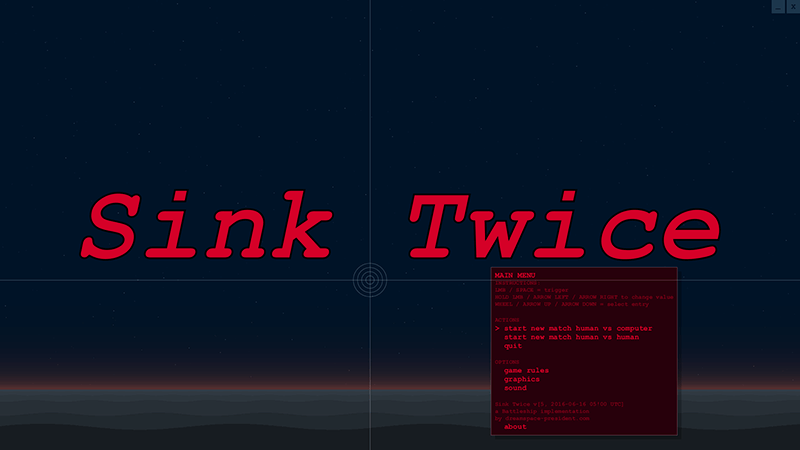
A Java 8 version of the classic game "Battleship" where you can play against the computer or against another human (hotseat). Notable features:
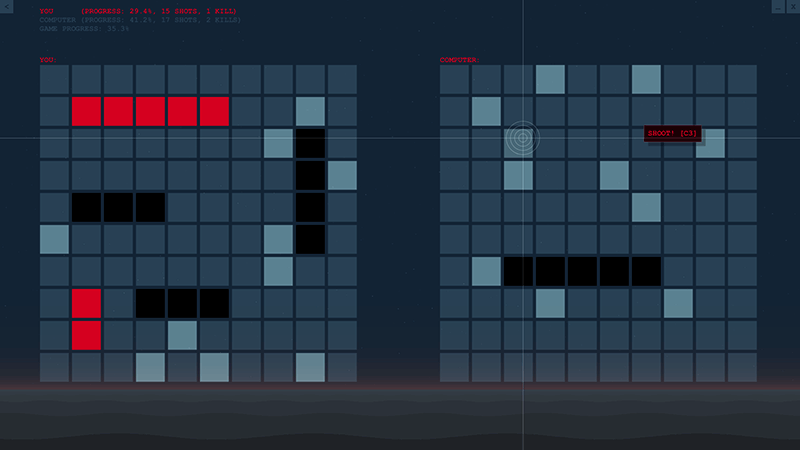
Doesn't quite sound like a contender for the crappy-section? Well, the graphics rendering is implemented in the simplest and most wasteful way, so what 2012 folk would have called a powerful computer is required, otherwise you might want to turn off anti-aliasing, the animated waves, and maybe the sky and stars too. The "procedural" music (which took only a few hours to implement) is also somewhat cheesy. And ... it's just boring old Battleship. Dreamspace President rather aims to create sophisticated stuff like the crappy prototype TinyTextAdventureForRevealingGameGifts very loosely hints at.
The reason I made this was that for unknown reasons, a forum post challenging readers to make a simple Battleship implementation resonated enough with me to start on Tuesday 2014-11-11. I stopped development after 14 days, partly because the result seemed sufficient and somewhat polished
I didn't sink twice about the name, it's just a working title that got stuck, nothing that actually reflects in the game. I'm German by the way, but I don't sound like the cliché.
System Requirements
PC, Java 8
▲ contents▲ contents
Radiation Maze
download v[2, 2020-09-27 07!00 UTC] (~100 KB Java 8 program)

In Radiation Maze (Unfinished but fun. Development started 2015-07-18. Working title was "Mazeaction".), The Consortium tasks you with sending clones into abandoned bases to gather uranium (Emitting deadly radiation. Don't get too close! Oh wait - you have to.) that's lying around there for some reason. For some other reason, there are, uh, "monsters" you have to avoid or from whom you even have to take uranium or cash that's lying around for some other reason.
Gameplay consists almost exclusively of just moving around with WASD or the arrow keys. The clone you sent can either leave without the full task accomplished, which will give you nothing except the money you banked by taking out monsters (or - psst - by selling health), or leave with all uranium gathered, giving you not only the cash money gathered but also the uranium - The Consortium really only cares about removing that hazard from those installations.
You have to press the use-key (e or numpad0) when at the entrance (which is simultaneously the exit) to get a menu, allowing you to make a few choices (which are confirmed with the enter key). Your game state will be saved (using safe saves plus one backup) automatically whenever you leave or enter a map.
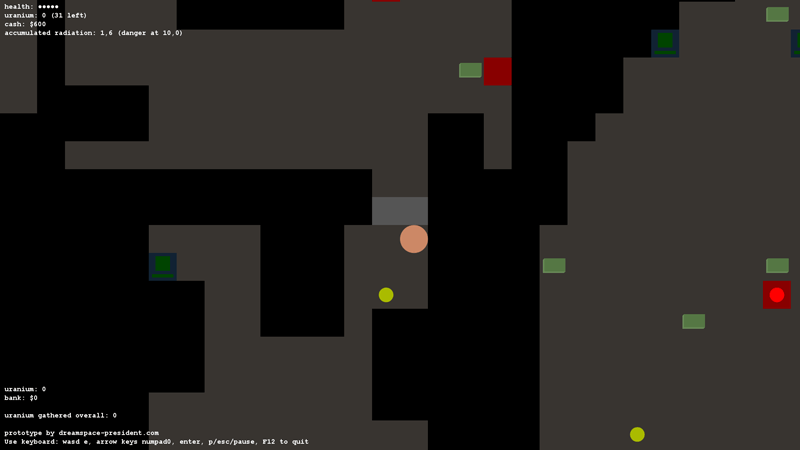
Sending a clone costs money, so don't leave without the task unfinished. Whenever you're too short on money, The Consortium will give you the necessary rest so that you can get going, but you're otherwise completely self-funded. If you don't have enough money but uranium, the necessary amount will be auto-sold before The Consortium would be asked for more.
Between missions, you can buy various permanent upgrades that greatly boost your clones' endurance and power. At first, you're an insect among monsters, but once you're maxed out, you're rather some guy mowing their front lawn on a Saturday morning, where each blade of grass is a monster. You will also have to purchase permanent access passes for higher level zones. You start at 1, max zone level is 12, and each map on whatever zone level you choose to tackle is randomly generated, which sometimes results in very small levels, sometimes very large ones. The higher the zone level, the more tightly woven the maze of rooms and the more monsters, uranium, and money there will be.

At first, there will be a bit of a grind before you reach reasonable survivability. Then there's the strife for improving the upgrades and obtaining more, and ultimately there's the strife for obtaining the luxury upgrades that make you utterly supreme, which might begin after about 2 hours. After two additional hours, you should be maxed out - and bored, because there's no endgame, story, or true variation. But it's fun to go through this nonetheless, at least I did so several times already.
One of the first upgrades you're likely to purchase is the Geiger counter which will henceforth be your permanent acoustic companion. All sounds in the game are synthesized in realtime, which mainly benefits the Geiger counter. Another of your early upgrade will probably be the ability to harm the monsters at all - or to snatch uranium/money from them with less risk. You will notice the halo upgrade, which is really expensive ... but it's worth it! You will become addicted to upgrading it further.
The reason this is in the crappy section is obvious: It's unfinished, there's no story or endgame, the upgrade menu between the maps is really rudimentary, the graphics are simplest procedural stuff (Though that's not a hard criterion: Sometimes less is more in regards to player fantasy.), there are no sound or graphics options, etc.. I do have a list of specific things in my Aceistant that I would like to improve, but I can't get myself to do it, so better than having a half-done game rot in a folder, I thought I'd just put it here.
System Requirements
PC, Java 8
▲ contents